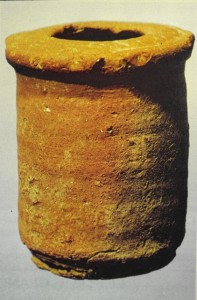Copying the Dead Sea Scrolls
The amount of data about the scribal practices, preparing hides, ruling, writing, ink and writing materials, attaching pieces and rolling of scrolls is enormous.[1] We can only survey a small amount of this data here. However, it seems that much of it is relevant to the way scrolls were written in biblical times, and it is certainly the case that the procedures required in tannaitic halakhah are in accord with many practices followed by the Qumran sectarians.[2] Interestingly, biblical scrolls from Qumran that are closest to the proto-Masoretic text type tend to be the ones that accord most closely with later rabbinic scribal rules. However, as codices developed and Torah scrolls became symbols with a ritual role to play, more and more specifications reflecting holiness and guaranteeing aesthetic concerns became associated with them in the rabbinic corpus.
Qumran scrolls are written mostly on skins of bovines, sheep or goats, and a small amount on papyrus, a material not permitted by later rabbinic law for biblical scrolls. The ink is a carbon-based vegetable ink, with no metallic content. It is normally black, with just a few words written in red, a practice not permitted by the rabbis for biblical scrolls. The script is generally the square script, known also as Assyrian or Jewish script, although a small number of texts are written in the paleo-Hebrew script or have divine names in that script, practices again forbidden by later tannaitic authorities. As required by tannaitic sources, the writing surface is rule by incising vertical lines to provide intercolumnar margins and also with horizontal lines for suspending the letters from them. The various methods of correcting manuscripts used in the scrolls are mostly permitted in rabbinic sources, but some are not.[3]
There has been much discussion about the methods employed for copying scrolls in terms of whether they are copied from other manuscripts or orally by listening. For Torah scrolls, rabbinic law requires direct, visual copying. Actually, the Scrolls bear witness to errors of both graphic and phonetic form,[4] but it appears that copies were generally made from other written copies.[5]
[1] Tov, Scribal Practices, 31-129.
[2] Tov, Scribal Practices, 274-76, L. H. Schiffman, “Hilkhot Sofrim u-Sefarim Bi-Megillot Midbar Yehudah uve-Sifrut Hazal,” forthcoming in Meghillot.
[3] Tov, Scribal Practices, 222-30.
[4] Tov, Scribal Practices, 18-19.
[5] Tov, Scribal Practices, 11.


Leave a Reply